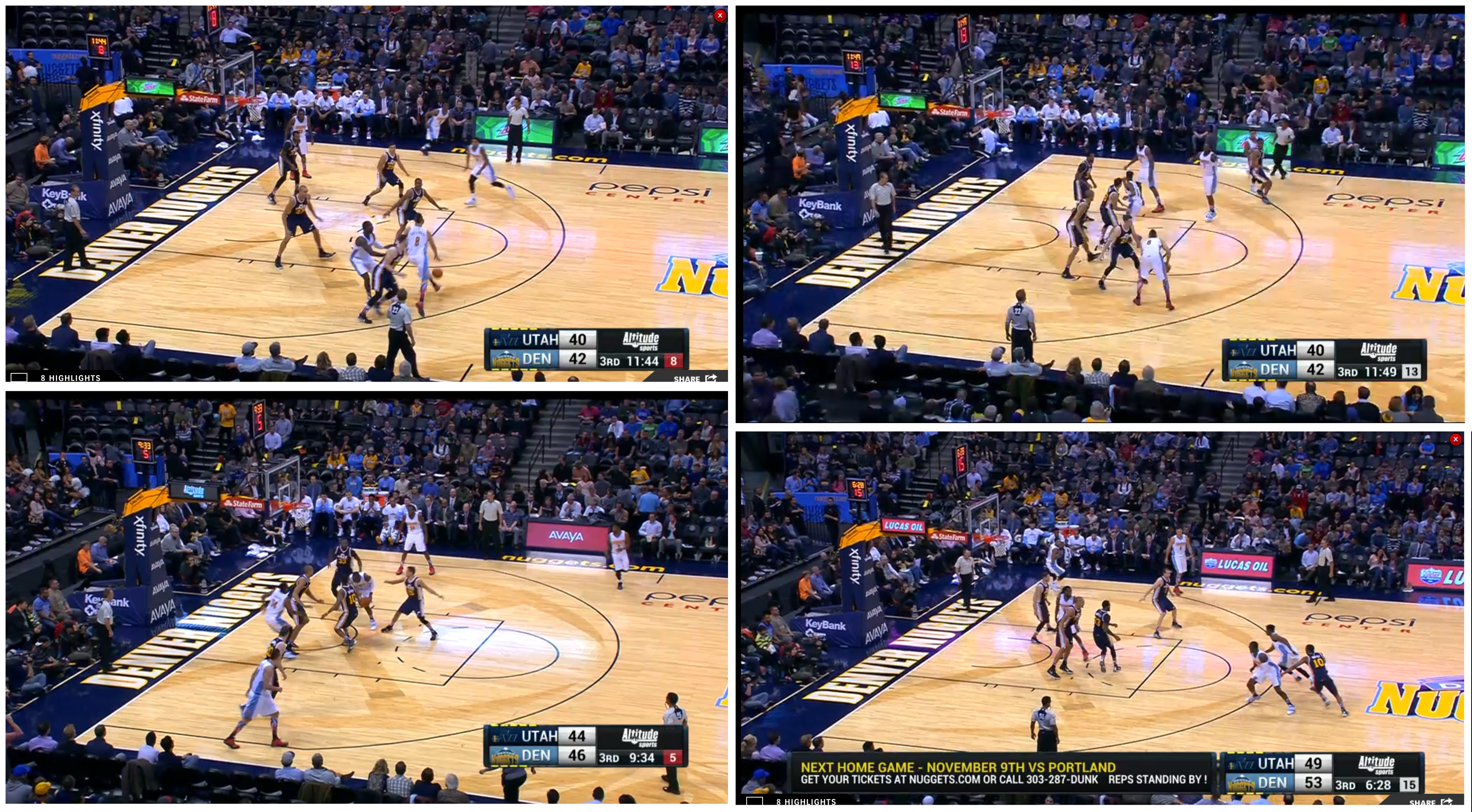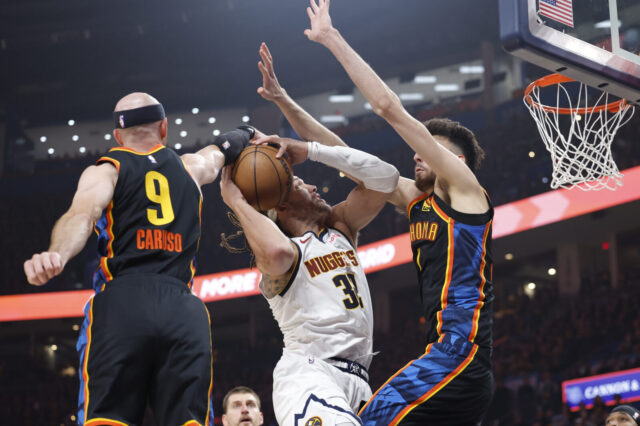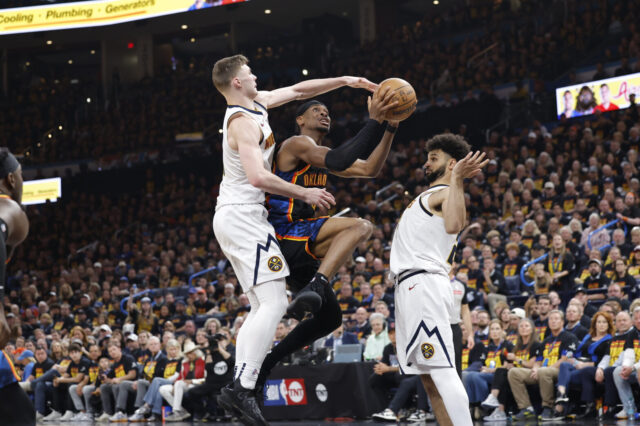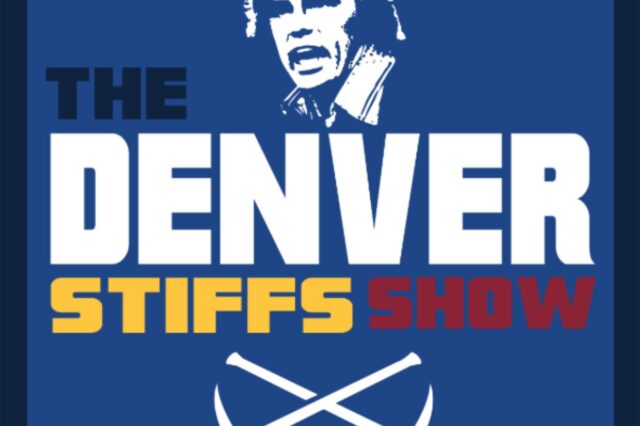The Denver Nuggets have a vicious feedback loop going on right now and it is fueled by their two biggest weaknesses: a lack of spacing, and turnovers.
The two issues play off of one-another. The team fails to protect the basketball and that leads to transition opportunities for their opponents. Transition possessions are the most difficult to defend and, teams are converting those turnovers against the Nuggets at a very high rate. As a result, their offense is continually forced to play against set defenses. Their complete lack of spacing on offense makes their half-court offense ineffective which gives opponents another opportunity to score in transition.
It’s a vicious feedback loop and it’s an instance of two flaws playing perfectly off of one another.
This content is no longer available.
Turnovers
The Nuggets are currently 4th to last in opponent points off of turnovers, giving up an average of 19.7 ppg off of turnovers alone. The team as a whole is allowing 103.6 points per game which means nearly 1/5th of the points that they are allowing per game come off of turnovers. In addition to the 19.7 ppg, opponents are scoring 1.15 points per possession against the Nuggets off of turnovers, 0.13 points per possession higher than they score following a made basket.
All turnovers are costly but the Nuggets seem to excel at the worst type of turnovers; live-ball turnovers. Dead ball turnovers are plays like throwing the ball out of bounds or getting called for an offensive foul. In those situations, the Denver defense is at least able to get back and get set up to defend. Live-ball turnovers happen off of things like steals or fumbling the ball where the defense can grab possession and push the ball up court in transition.
Mudaiy has been the biggest culprit. His 5.3 turnovers per game is highest in the league and many of them have come in live-ball situations or in the open court. He has showed some signs of improvement. Through the first four games he was averaging 6.25 turnovers per game and over the last three games he’s cut that in half, down to an even 3 per game. The team as a whole has improved on their turnover problem. They had 16 or more turnovers in each of the first three games and ten or fewer in three of the last four, their 20 turnover game against Golden State being the lone exception.
Spacing
Part of the reason for the high turnover rate is that Mudiay is young and inexperienced and needs to develop a better handle, better chemistry with his teammates, and a better feel for the game. However, another part of the team’s struggles can be attributed to a complete lack of spacing. The Nuggets are shooting just 36.5% on uncontested field goal attempts, per SportVu, good for 27th in the league. The Nuggets struggled with shooting last season and, just like last season, teams are starting to really sag off into the paint, knowing that the Nuggets can’t make them pay for it.
Most of the shooting struggles can be attributed to personnel. Few players in the Nuggets rotation shoot the ball at an elite level or have earned a reputation as a player that ‘can’t be left open.’ Gary Harris and Will Barton are both career 24% 3-point shooters and combined play a majority of the team’s minutes at shooting guard. The issue is compounded by the fact that two of the team’s best players, Emmanuel Mudiay and Kenneth Faried, provide almost no perimeter spacing. In today’s NBA, it is becoming increasingly rare to feature more than two non-shooters on the court at any given time so with both of those two players in the starting lineup, the other three starters must stretch the court.
A few months back, Steve Shea and Christopher Baker provided a fascinating examination of the most offensively efficient 5-man lineups in the league in terms of creating spacing. In their study they discovered that of the top 15 5-man lineups in terms of spacing, 14 had at least three players who shot above 33.3% from behind the arc and attempted at least 0.05 3-pointers per minute played. Nine of those 15 lineups had at least four such players. In short, having shooters on the court means that defenses get spread out, the paint is more open, and offenses score more efficiently.
The Nuggets just don’t have enough shooters to create such lineups, especially not without sacrificing a lot on the defensive end.
Spacing has been especially difficult to come by in the lineups that feature Hickson and Faried alongside Mudiay and Harris. In the screen shots below you can see how the Jazz were able to keep three or four guys in and around the painted area, especially their front court players, who aren’t drawn out to cover Hickson or Faried. Too many of the Nuggets possessions in the half court looked this way in the early part of the season.

Michael Malone has been searching for ways to open up the paint. In the win against the Trailblazers last night, the team was able to manufacture some spacing through ball movement. When asked at practice on Monday about creating spacing, Malone said “We can’t try to beat a team that packs the paint with one pass and one shot. The reality is, the more you move the defense one side, two sides, back to the third side, you’ll get a much better shot.”
One set that is a good example of how ball movement can open up the paint is a popular NBA set commonly referred to as “Slice Stagger.” The key component of the action is that it moves the ball across the width of the court a couple of times while creating a series of screens and cuts, one after the other. The Nuggets ran this set several times against the Trailblazers and as a result the paint opened up. In that game, the Nuggets scored 50 points in the paint, up 8 points from their season average. That might seem fairly small but 8 points in the paint is the difference between the 15th ranked Nuggets and league leading Oklahoma City Thunder.
The poor perimeter shooting has a direct correlation to the team's poor efficiency in the paint, especially for Mudiay. Mudiay has shot an amazingly low 27% in the restricted area so far this season. That number is especially interesting since his size and skill set led many to believe that he'd be great at scoring at the rim, along the lines of a player like Derrick Rose. Mudiay's signature play throughout summer league was the hard drive into the paint that collapsed the defense and the incredible cross-court, on-point kickouts that he seemed to pull out of nowhere. Those plays had disappeared from his game and instead he had been finding awkward handoffs and worse, turnovers on doomed drives into the teeth of a set defense that has been allowed to leave a rim protecting big or two in the paint to challenge him.
The spacing issue might not have an easy solution. Malone and the team can work on ball movement and do some things to try and manufacture spacing despite not having enough reliable shooters on the court at all times but teams will still have the luxury of packing the paint against Denver. The addition of Wilson Chandler should help some and the eventual return of Jusuf Nurkic may allow Malone to play lineups that feature four smaller players since Nurkic alone can protect the rim. However, the issue won’t fully be resolved until the team adds or develops more reliable shooters.
The turnover issue is much more correctable and will likely improve with time. Turnovers leading to half court sets with poor spacing, leading back to turnovers has been the theme of the first two weeks of the season but it is perfectly reasonable to expect there to be at least some improvement in those areas over the course of the season.
For now, the Nuggets are fighting against a vicious cycle.


